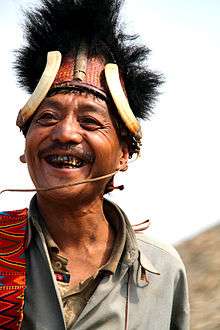Konyak Naga
The Konyaks are one of the major Naga[1] ethnic group. In Nagaland, they inhabit the Mon District—also known as 'The Land of The Anghs'. The Anghs/Wangs are their traditional chiefs whom they hold in high esteem. Facial tattoos were earned for taking an enemy's head.[2]
| Total population | |
|---|---|
| 320,000 approx. (India and Burma) | |
| Regions with significant populations | |
| Nagaland and Naga Self-Administered Zone | |
| Languages | |
| Konyak language | |
| Religion | |
| Christianity and Animism | |
| Related ethnic groups | |
| Wancho, Other Naga people |

Other unique traditional practices that set the Konyaks apart from the rest are: gunsmithing, iron-smelting, brass-works, and gunpowder-making. They are also adept in making 'Janglaü' (machetes) and wood sculptures.
Festival
Aoleng, a festival celebrated in the first week of April (1-6) to welcome the spring and also to invoke the Almighty's (Kahwang) blessing upon the land before seed-sowing, is the biggest festival of the Konyaks. Another festival, 'Lao Ong Mo', is the traditional harvest festival celebrated in the months of August/September.

Society
The Konyaks have the largest population among the Nagas. They are found in Tirap, Longding, and Changlang districts of Arunachal Pradesh; Sibsagar District of Assam; and also in Myanmmar. They are known in Arunachal Pradesh as the Wanchos-- 'Wancho' is a synonymous term for 'Konyak'. Ethnically, culturally, and linguistically the Noctes and Tangsa of the same neighbouring state of Arunachal Pradesh, are also closely related to the Konyaks. The Konyaks were the last among the Naga tribes to accept Christianity. In the past, they were infamous for marauding nearby villages of other tribes, often resulting in killings and decapitations of the heads of opposing warriors. The decapitated heads were taken as trophies and usually hung in the 'Baan' (a communal house). The number of hunted heads indicated the power of a warrior. The headhunting expeditions were often driven by, and founded on certain beliefs, code of honour; and, principles of loyalty and sacrifice.
The tribal members maintain a very disciplined community life with strict adherence to duties and responsibilities assigned to each of them.
Language
The Konyak language belongs to the Northern Naga sub branch of the Sal subfamily of Sino-Tibetan.
See also
References
- 'Konyak Nagas' by Christoph von Furer-Haimendorf, (1969)
- https://qz.com/india/1136007/the-konyaks-of-nagaland-indias-famed-tattooed-headhunters-are-a-vanishing-tribe/
Further reading
- Stirn, Aglaja & Peter van Ham. The Hidden world of the Naga: Living Traditions in Northeast India. London: Prestel.
- Oppitz, Michael, Thomas Kaiser, Alban von Stockhausen & Marion Wettstein. 2008. Naga Identities: Changing Local Cultures in the Northeast of India. Gent: Snoeck Publishers.
- Kunz, Richard & Vibha Joshi. 2008. Naga – A Forgotten Mountain Region Rediscovered. Basel: Merian.
- Alban von Stockhausen: Imag(in)ing the Nagas: The Pictorial Ethnography of Hans-Eberhard Kauffmann and Christoph von Fürer-Haimendorf. Arnoldsche, Stuttgart 2014,.
- ISBN 978-3-89790-412-5.
